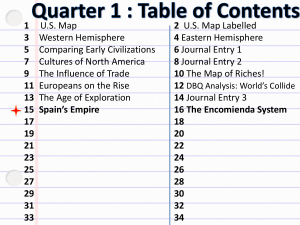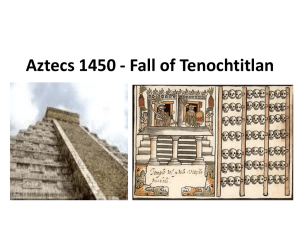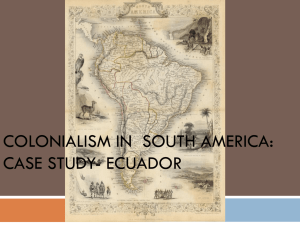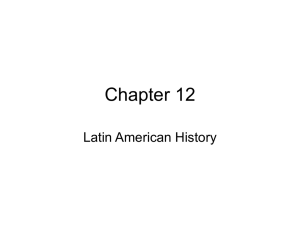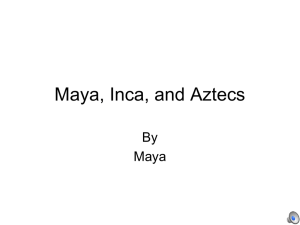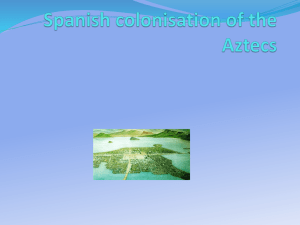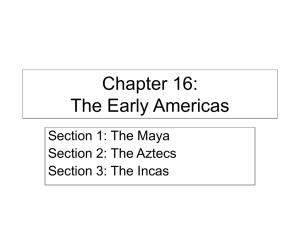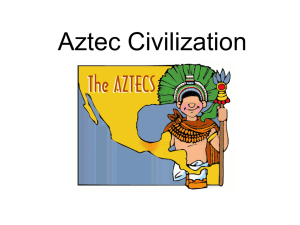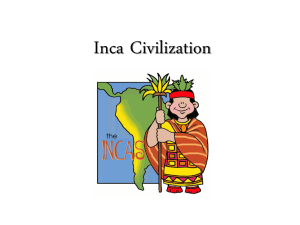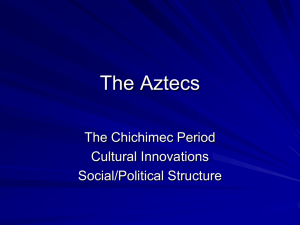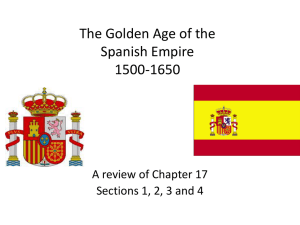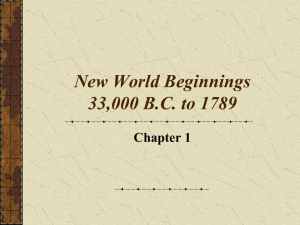Pizzaro, and Independnce of South America ppt
advertisement
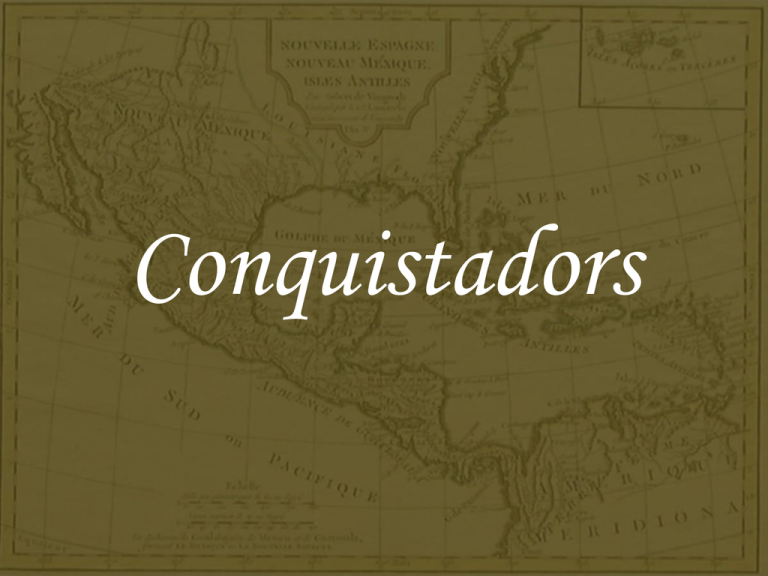
Conquistadors Who were they? • Conquistador is a term that means “conqueror” in in Spanish and Portuguese, but is widely associated with the Spanish soldiers, explorers, and adventurers who brought much of the Americas under the control of Spain in the 15th through the 19th centuries following Europe's discovery of the New World by Christopher Columbus in 1492. The Conquests • The stated purposes of these conquests were to equally spread the word of God and to bring this new civilization in the most obscure parts of the world into the Spanish Crown as dutiful vassals. • However, Spanish Conquest of Americas were a series of unfortunate and morally questionable acts driven by greed for gold and resulted in the destruction of several native civilizations. Famous Conquistadors • Hernan Cortez – Famous for leading an expedition into Mexico and defeating the Aztec Empire at Tenochtitlan. • Francisco Pizarro – Famous for leading an expedition into South America and defeating the Incan Empire. Hernan Cortez The Aztecs • The Aztecs were the largest group of people living in Mexico at the time of Spanish arrival. • Like the Olmecs and the Mayans before them, Aztec culture had rich and complex mythological and religious traditions, developed social structure, as well as reaching remarkable architectural and artistic accomplishments. Tenochtitlan • The Aztecs were, by far, the largest group in Mexico by the year 1500. • The population was around 30 million and they were immensely wealthy from conquering neighboring lands. • At the heart of the empire was the grand city of Tenochtitlan. This capital city was estimated to have over 200-300,000 inhabitants. • According to records, that would make it one of the largest cities in the world at the time. Compared to Europe, only Paris, Venice and Constantinople would have been larger. Tenochtitlan The Aztecs – Did You Know? • Aztecs did not refer to themselves as Aztecs, but as the Mexica. • Aztecs believed that the gods sacrificed themselves so that humans could live. The Aztecs would in turn would make human sacrifices as repayment to the Gods. Many times they would eat the flesh and drink the blood of the sacrificed. Sound familiar? • Aztecs had a complex calendar based on astrology, similar to the Mayans and Olmecs. • Tenochtitlan had a zoo, botanical gardens and even 12 saltwater ponds or “aquariums”. Apocalypto • The movie Apocalypto is set in Mexico, during the period of the Aztec and Maya civilizations. It depicts the journey of a young tribesman who’s village was brutally attacked by Atzecs looking for slaves and humans to sacrifice to their gods. He must escape capture and rescue his family in this intense, historical thriller. Cortez and the Spanish Arrive • When Cortez arrived at Tenochtitlan he was amazed by what he saw. • The city was far grander than many he had ever seen. • Cortez and the Spaniards were received by Montezuma, the Aztec emperor. • Montezuma was reluctant to invite the Spaniards in, though many Aztecs believed they were descendants of the gods. Did you know? • Some legends refer to the God Quetzalcoatl as a stranger from a distant land who sailed to their shores upon a “magic raft of serpents.” • Other gods such as Itzamna and Kukulcan, were both portrayed as bearded men who led their ancestors into Mexico. • Such similarities to the Spanish arriving on large boats and sporting beards and strange armor may have led the Aztecs to welcoming them as Gods. The carving above and The statue to the left depict Men with beards, similar to how Hernan Cortez and the Spanish would have worn them. The Siege of Tenochtitlan • Equally wary of the natives, Cortez took Montezuma captive. • Along with an army of natives that he had made treaties with, Cortez and his men laid siege to the city. • Many Aztecs were massacred during an annual festival. • Cortez and his men were able to escape the city with vast amounts of gold. • The Spaniards then cut off the outskirts of the city so that no one could get in or out. • Without food, water and supplies, the Aztecs started to starve as famine and small pox epidemics broke out which killed most of the Tenochtitlan inhabitants. • Even as many Aztecs surrendered, they were slaughtered by the Spanish. • Through battles, famine, disease and slaughter, it is estimated that over 200,000 Aztecs died during the siege that lasted 80 days. The Siege of Tenochtitlan Tenochtitlan • Following the siege, Cortez and the Spaniards and their native allies looted the city, slaughtered any remaining inhabitants. • Cortez directed the destruction and leveling of most of the city which was then re-built for Spanish use. Today, Mexico City is built on top of the ruins of Tenochtitlan. • It wasn’t until the 1970’s when the construction of the metro line in Mexico City that the ruins of the Temple Mayor was uncovered. A small excavated portion is available to the public. Temple Mayor Inca and Pizarro Francisco Pizarro • Early South American explorers would bring back tales told by the natives of a gold rich territory called Piru. • This immediately got Pizarro’s attention and he put together an expedition. Conquest of Peru • While in Peru, Pizarro encountered a group of natives known as the Incas. The Incas • The Incas were the largest group of natives in the New World. • It is estimated that their total population was upwards of 40 million prior to Spanish arrival. • The Incas were known for building a complex network of roads and fortresses. They are sometimes referred to as the “Romans of the New World.” • The Incans were also very wealthy with gold. Since their was no iron or other metals, so Incans often made everyday household items out of the precious metal. The Incan Empire Machu Picchu Did You Know? • Despite all their complexities, the Incas actually did not have an official system of writing. • In fact, they used a system of knotted string or rope called quipu to help keep records and calculate math. Human Sacrifice and Mummification • Like the Aztecs, Incas would also practice human sacrifice. They would take their children (who were pure) out into the mountains and leave them for their gods. Children would die from exposure to the elements. • The Incas were also well known for their mummies that have been found. Many of them are the sacrificed children who had frozen to death and became a “natural” mummy. Mummies Conquest of Peru • When encountering the Incas, Pizarro tried to negotiate with the Incan emperor Atahualpa. • When Atahualpa refused the Spanish, Pizarro attacked and captured the Incan emperor. • The Spanish held Atahualpa for ransom, demanding the Incans to fill an entire room of gold and silver. • When the Incans complied, the Spanish killed Atahualpa anyway. Conquest of Peru • Pizarro and the Spaniards took their gold and then continued on their conquest. • The Spanish finally defeated the Incas at their capital city of Cuzco and within a year, he had conquered all the Incas and Peru. • Pizarro wanted to establish a capital city of the recently conquered territory but the Incan capital was too far inland. • Pizarro then established the city of Lima on the coast.
